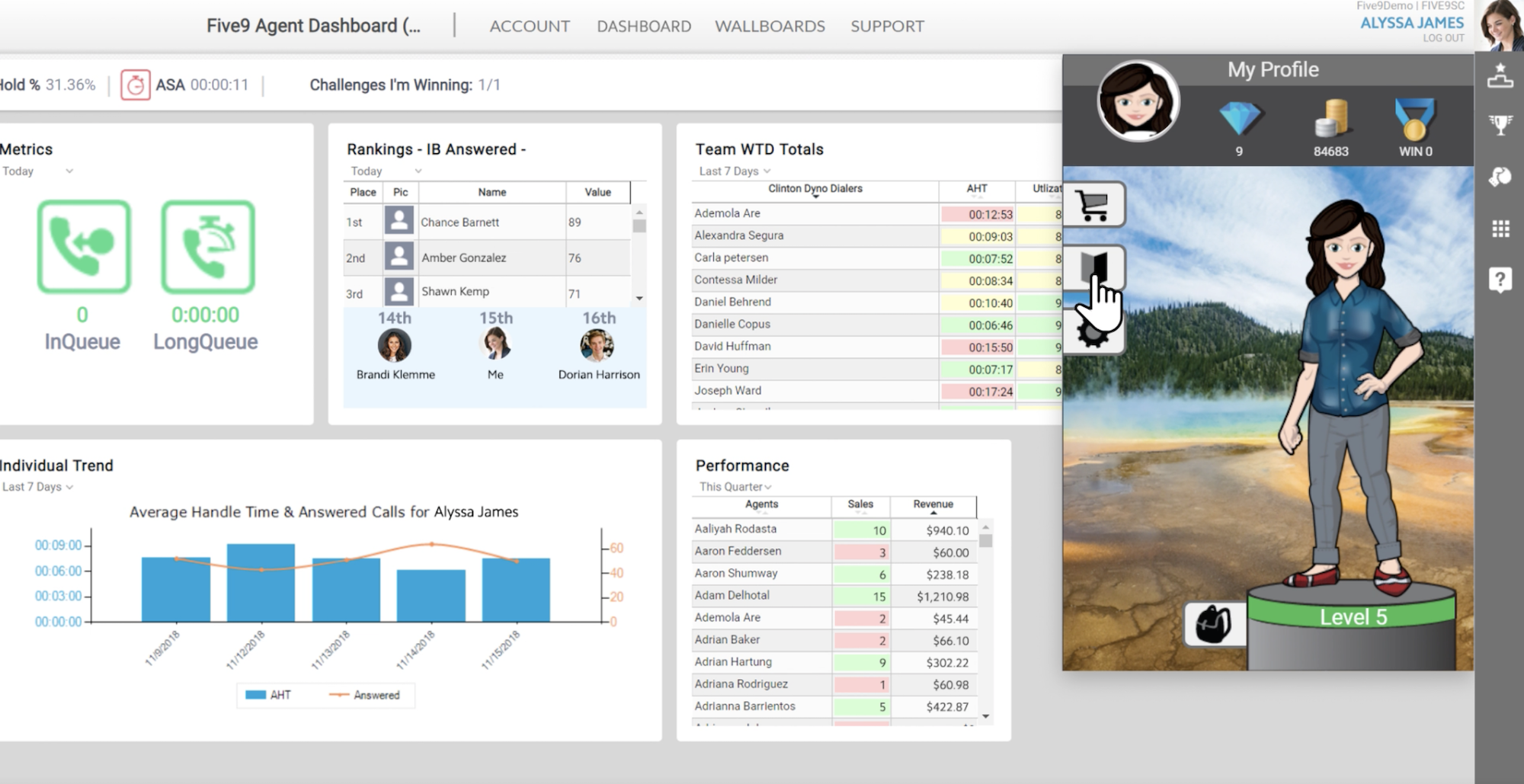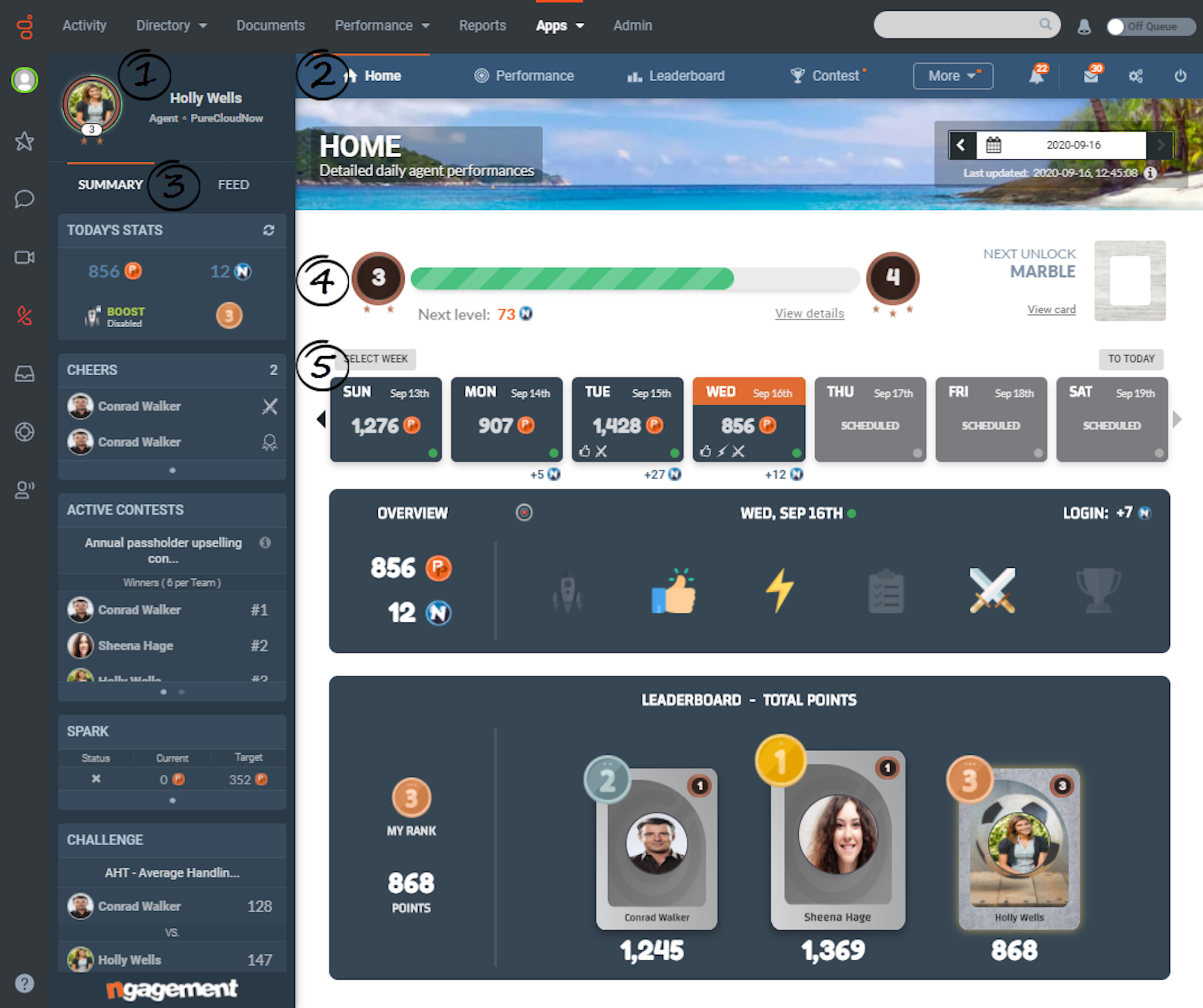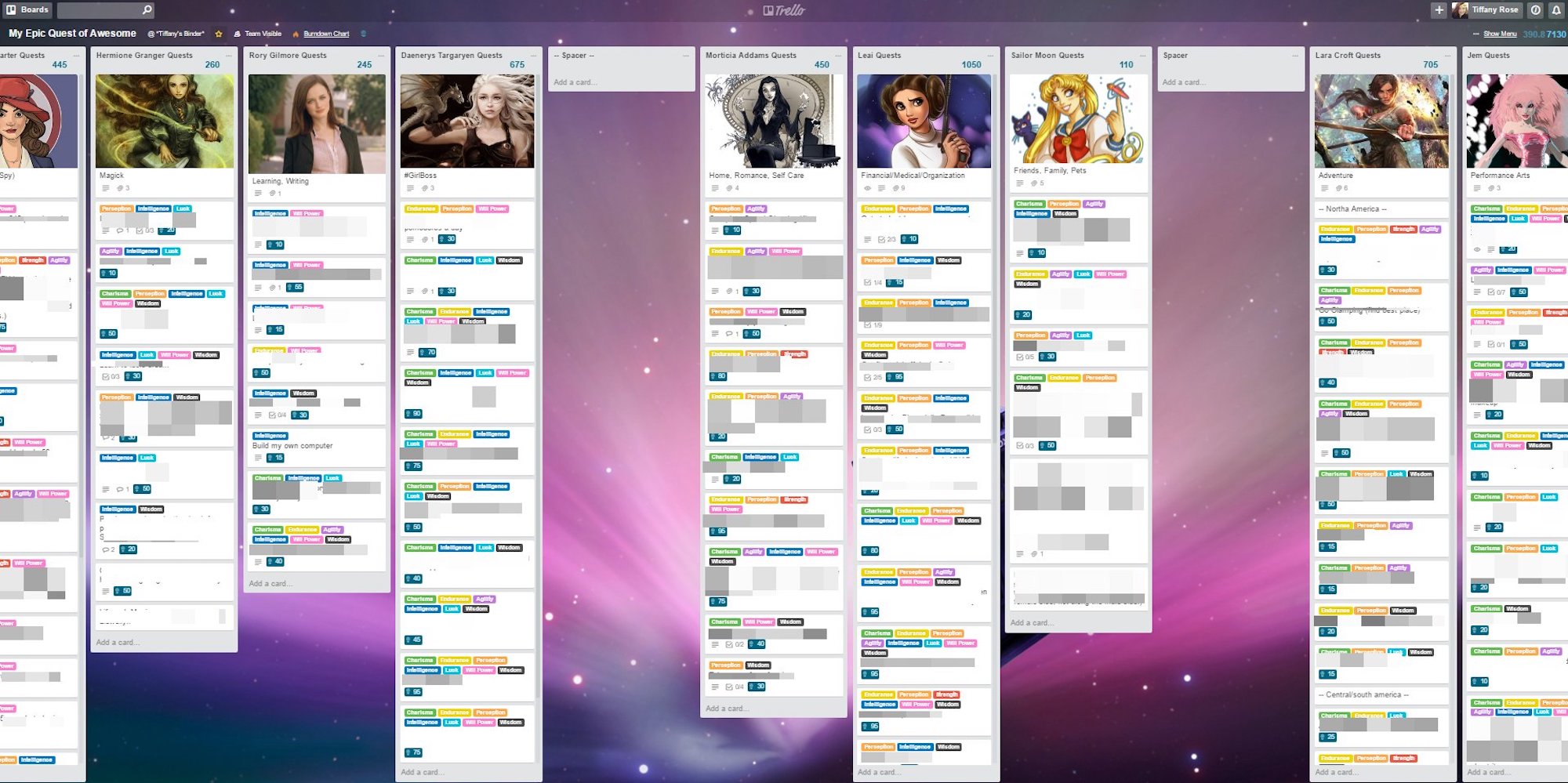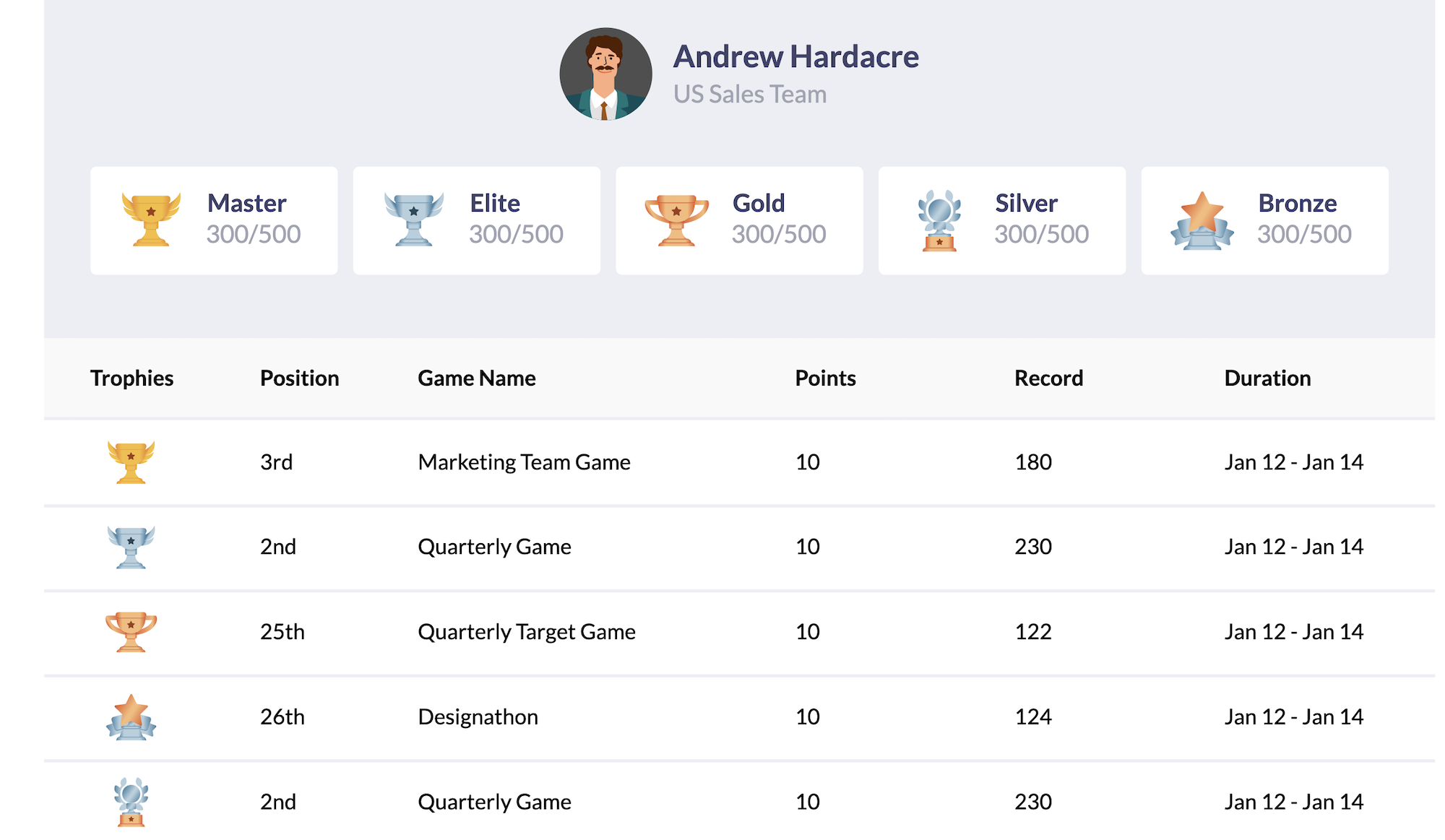Call center gamification is a fun, engaging, and incredibly effective way to improve agent performance, increase productivity levels, foster a sense of teamwork even within a remote work environment, and of course, make more sales.
Top contact center providers like Genesys, NICE CXone, and Five9 offer native gamification features as a part of their workforce optimization tools, while other platforms like Dialpad and Talkdesk connect with third-party gamification integrations.
But what is call center gamification, and what are the best gamification techniques and tools?
Read on to find out.
What is Call Center Gamification?
Call Center Gamification is an employee engagement and performance incentive strategy that turns call center activity and KPI monitoring into interactive, often company-wide games with leaderboards, points, and rewards.
Gamification is used for ongoing, long-term employee performance and customer satisfaction monitoring, as well as time-bound and goal-based activities. Gamifying standard call center wallboard analytics makes it much easier–and much more entertaining–for admins and business owners to simultaneously monitor departments, individual agents, project progress, and even overall company activity.

Popular call center metrics and business processes to gamify include:
- Employee training and coaching
- Hold times and customer wait times
- First call resolution rates
- Sales revenue and number of sales generated
- Number of outbound calls made
- Number of inbound calls accepted
- Customer satisfaction (Calculated CSAT score or based on customer survey feedback)
- Call transfer rates
- Customer journey length
- Number of missed calls
- Average Handle Time (AHT)
- Call queue lengths
- Schedule adherence
When choosing metrics to monitor, it’s important to select metrics agents truly have control over, not metrics that are primarily influenced by outside factors like customer availability, supervisor schedules, or software malfunctions/downtime.
Key Elements of Successful Call Center Gamification
Regardless of game mechanics, goals, types, or players, there are a few key elements that make games successful, engaging, effective, and even addicting.
These are the most important game elements to take into account when developing your call center gamification strategy:
Motivation
Consider not only what motivates your call center agents to play the game, but also what motivated you to create the game as a call center manager or supervisor.
Contact center agents are likely to be the most motivated by the game rewards, the sense of competition, and the subsequent recognition that comes from winning the game or completing the challenge.

Admins, managers, and business owners will likely be motivated by profit, cost savings, increased productivity levels, lower turnover rates, higher customer satisfaction levels, and greater insight into day-to-day call center activity.
Clear Benchmarks of Success
Determining your motivation for developing a game makes it easier to define and explain game rules, choose and measure performance thresholds/KPIs, and create scoring systems and objectives.
Popular scoring systems include:
- Ranked leaderboards
- Game levels
- Point system
- Number-based scoring (number of calls accepted, number of sales made, etc.)
- Dollar-based scoring (total value of sales made, etc.)
- Moving game spaces/pieces
- Badges
- Graphs and charts
- Grades
- Star ratings/rankings
- Progress percentages
Consider what the value of each point/percent/star, etc. is, what causes agents to gain or lose points, and how many points are needed to win or complete the game.
Decide how often you’ll update the score (fortunately, automated scoring and updating is a key component of gamification tools) and if agent scores should be public or private.
The way you define and measure success within the game must be clear, simple, uniform, and consistent–because these benchmarks allow agents to self-evaluate and understand how they rank in comparison to their colleagues.
Feedback and Recognition
Scoring systems and prizes aren’t just incentives for team members to keep playing games–they also provide an opportunity for employee recognition among colleagues and higher-ups.
Call center employees want to know their successes and hard work haven’t gone unnoticed, and that positive, public, and instant feedback is just as valuable to many of them as a physical or monetary prize. Proper recognition is a huge factor in employee retention: Over 80% of employees want more workplace recognition, and a lack of adequate recognition is one of the top three reasons why employees quit–alongside a low salary and a lack of potential for growth.

But not all feedback needs to be publicized, and not all of it has to be 100% positive. Lower scores on games can indicate a lack of employee interest/engagement/effort, or they may signal that employees just don’t understand the material.
If you notice some team members are far behind their colleagues, you can address the issue early via one-on-one coaching, assigned training manuals, private meetings, or even performance reviews where you and the agent review the contexts and recordings of unsuccessful customer interactions. This type of feedback makes team members feel valued, makes expectations clear, and gives them the opportunity to improve.
In addition to helping team members improve their performance, you’ll also gain valuable insights about your own strengths and weaknesses as a manager.
Learning and Reinforcement
While increased productivity and more sales are certainly a major benefit of successful gamification techniques, the real goal of these games is to help your agents become better employees. Ideally, agents learn something from each round, level, or complete game–and future gameplay helps to reinforce the game’s lessons.
If an agent doesn’t pass a level, make it to the next round, or if they lose the game, they’ll play it again until they make progress.
Continual game participation reinforces agent knowledge of endless topics and agent skills, including:
- Training materials
- Call scripts
- Internal knowledge base
- Company performance expectations
- Training modules
- HR policies
- How to operate business software
- Answers to common customer questions
- Successful sales pitches and tactics
- Time management/time required for certain tasks
- Effective team collaboration and communication techniques
- Cold calling skills
Benefits of Gamifying Your Call Center
While team collaboration software and task management apps streamline workflows and clarify employee responsibilities, they usually can’t compete with the fun, excitement, and satisfaction that gamification brings to your workplace.
Below, we’ll review the top gamification benefits, and explain just why it’s such an effective engagement tool.
Decreased Employee Turnover Rates
The call center employee attrition rate of 42% is one of the highest in today’s workforce–so finding a solution to employee turnover is top of mind for call center managers.
Given that 65% of employees aren’t engaged in their work, developing a strong agent engagement strategy is the first step.
Making gamification a part of your workplace increases employee engagement by nearly 50% and decreases employee turnover by 36%--and it’s easy to see why. Gamification makes the workplace fun, has a social component, makes training much more interesting, and offers real-time performance feedback and employee recognition.
The engagement and entertainment of gamification also increases employee satisfaction levels and boosts morale, as 88% of agents say gamification makes them happier at work.
Increased Productivity and Sales
Nearly 90% of employees say gamification elements make them more productive at work, and over 70% of team members say gamification motivates them to work even harder than usual.
But all this extra work may not be necessary–at least not when it comes to reviewing training materials– as gamification boosts employees' ability to remember the new skills they’ve learned by up to 40%.
How does gamification make this happen?
In addition to the more obvious reasons like a better knowledge of training materials, a sense of competition, and the promise of rewards and recognition, the answer could be decreased stress.
While some companies may initially question the idea of company-wide sales rankings displays, the fact is that visible goal tracking metrics, like gamified leaderboards, can increase sales by up to 33%.
Some companies have even been able to use gamification techniques to achieve conversion rates 7 times higher than previous ones.
Effectively Monitor and Evaluate Employees
While call center analytics give admins a view of daily activity, call volume, and overall agent performance, they don’t always provide the whole picture.
Gamified performance data makes it much easier for managers to quickly evaluate quality management KPIs and productivity levels in one place–the call center wallboard. Looking at a quick list of your most important metrics is much faster than constantly generating and reviewing in-depth analytic reports.
Gamification provides a unique way to monitor in-house and remote employees, identify top talent, and optimize agent performance and schedules. Managers can create challenges designed to offer insight into specific KPIs like outbound call volume or sales revenue per agent.
Call Center Gamification Ideas and Techniques
As with traditional gameplay, call center gamification uses a variety of different elements to apply “pressure” and create incentives for the players (your call center agents.)

When brainstorming how to gamify your call center, consider popular gamification elements and approaches like:
Leaderboards
Leaderboards are “always-on” game/agent rankings and scores that are updated in real-time and, in most cases, visible to the entire company either virtually or in-office. Leaderboards have long been considered one of the most effective ways to use gamification to motivate agents and create a sense of friendly competition. Display the top 3, 5, or 10 spots–or give company-wide ranking a try. Create alerts when leaderboard positions change.
Player Avatars, Characters, Profiles
Each agent should be able to customize their own avatar by choosing their name, hairstyle, clothing, eye color, and even personality traits. Some games may require participants to choose from a variety of preset characters, while others let agents create profiles with their photo, job title, team, or department listed.
Whatever you opt for, letting agents create their own “in-game” experience and player provides personalization and social engagement with other team members, two highly motivating game-playing factors.
Badges and Trophies
Virtual badges and trophies let agents showcase their past achievements to other employees and are a great way to mark the completion of smaller changes or agent milestones within a larger competition. Agents could receive badges for every 10, 50, or 100 calls made, for every 2 hours of talk time, for every $500 in sales revenue generated, or whatever other metric you choose.
Countdowns and Timers
Entire games, or smaller tasks within a larger game, can have time limits and countdowns to motivate team members for short bursts. Having highly visible real-time countdown clocks, even for longer competitions, serve as a reminder and motivator–and can be a great tool to use to achieve some last-minute results before the end of the week or a business quarter.
Worldbuilding
Worldbuilding and simulation games give team members the chance to create, customize, and rule their own worlds from the ground up. In addition to the obvious management and leadership skills worldbuilding games foster, these games are incredibly addictive and engaging! (Remember Farmville, Age of Empires, The Sims?)
Worldbuilding gamification is an excellent way to maintain employee engagement and interest over longer periods of time, and helps to make more mundane topics exciting.
Goal-Based Challenges
Challenges are short-term, one-time competitions with a clear and simple objective like, “The first agent to make 100 outbound calls wins a $50 giftcard to the restaurant of their choice,” or “If we can clear out our callback queue in three hours, everyone can come into work an hour later tomorrow.”
If goals are not met, no prize is given.
Team-Based Play
While some call center activity only makes sense to measure on an individual level, there are numerous metrics perfect for team-based play. Creating teams of agents randomly, by department, by skill set, or by any other category you’d like is an excellent way to increase teamwork, accountability, and collaboration. It’s an especially effective strategy for engaging employees that may not be motivated by a sense of healthy competition or gameplay, because it takes the focus off individual success and places it instead on the idea of supporting teammates.
Puzzles
Whether it’s a word search, a crossword, a memory-based game, or even a virtual version of a traditional puzzle, giving call center agents one piece at a time is a great reminder that all their actions are a part of a larger picture.
Battles
Especially for team members that thrive under pressure and enjoy competition, one-on-one, boss battle-style games are a fun way to identify top performers, help weaker agents learn from more experienced ones, and create a sense of camaraderie between employees by having them cheer each other on.
Head-to-head battles can also help increase sales during slumps, give morale a major boost, and encourage your best agents to outperform each other.
Quizzes and Tests
Gamified quizzes and tests make employee training–both onboarding and continuing education–more engaging. Comparing agents’ test scores provides insight into which parts of your training materials need revision, and which aspects are the most difficult for employees to master.
Tests can be administered at random, at the end of each training manual or webinar section, or on HR topics and company rules. Ensuring your team is familiar with business standards, the knowledge base material, and effective ways to deal with difficult customers before they connect with callers leads to a better customer experience, increases customer loyalty, and keeps the resolution process going smoothly.
Simulation and Storytelling
Creating an engaging narrative that elicits an emotional response in your team members is the basis of any quality simulation or story-based game. As agents meet benchmarks, hit a certain number of customer interactions, or score a certain percentage on a test, they can advance further into the story.
Improve on linear storytelling by giving your agents the chance to “choose their own adventure” via choice-based narratives.
Strategy, Scarcity, Resource Allocation
Resource allocation games are an excellent model for budget management training, while scarcity-based games keep employees motivated, focused on the task at hand, and encourage creative thinking. Strategic games encourage collaboration, improve the decision-making process, and can help break up the sometimes routine nature of call center operations.
Chance-Based Games
Chance-based games, alongside surprise in-game challenges or sudden changes to the rules, perfectly prepare team members for how to find creative solutions to unexpected situations like supply chain issues, peak season understaffing, or customer complaints. These games teach employees how to think on their feet and how to keep their cool under pressure.
Reward Ideas for Winners
Developing gamification rewards for call center agents is one of the most important –and fun–parts of the process.

Your reward system needs to consistently motivate agents while remaining:
- Attainable: The points or performance metrics needed to obtain the rewards should be reasonable, take place in a sensible timeline, and in line with current company expectations. If rewards aren’t realistic, or worse, seem intentionally unattainable, gamification may have the opposite intended effect on agents.
- Fair Compared To Performance Expectations: Rewards should reflect the level of effort required, as well as the length of the game/challenge itself. A $10.00 coffee shop coupon won’t motivate agents to increase their talk time by 50% in 2 months, but it could be the perfect reward for a 30-minute sales revenue generation race.
- Desirable: Make sure rewards are what your agents actually want, not just what you think they want, by creating polls or asking for reward ideas at meetings.
Some of the most popular employee rewards include:
- Cash incentives and gift cards to restaurants, spas, movie theaters, online shops, etc.)
- Extra hours or days off work or the chance to work an extra day from home
- Free lunch or in-office treat delivery (cupcakes, cake, donuts, etc.)
- Charitable donations to winner’s nonprofit of choice
- Company happy hours or other team outings (bowling, laser tag, cruises, etc.)
- Virtual Rewards Booth where agents can “cash in” their points for physical items
- Avatar upgrades (outfits, hairstyles, accessories, etc.)
- Simulation-based rewards (Upgrading virtual home, in-game advantages, access to exclusive in-game features, ability to choose virtual teammates, etc.)
Regardless of the rewards you choose, don’t forget that employee recognition should be included alongside the reward. Make sure winners feel recognized among their colleagues by hosting virtual awards ceremonies, sending a company-wide congratulations email or instant message, making an in-office announcement, or highlighting the winner’s name on the leaderboard.
FAQs
Below, we’ve answered some of the top call center gamification FAQs.



